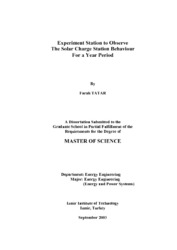Please use this identifier to cite or link to this item:
https://hdl.handle.net/11147/3789Full metadata record
| DC Field | Value | Language |
|---|---|---|
| dc.contributor.advisor | Atagündüz, Gürbüz | en |
| dc.contributor.author | Tatar, Farah | - |
| dc.date.accessioned | 2014-07-22T13:52:22Z | - |
| dc.date.available | 2014-07-22T13:52:22Z | - |
| dc.date.issued | 2003 | en |
| dc.identifier.uri | http://hdl.handle.net/11147/3789 | - |
| dc.description | Thesis (Master)--Izmir Institute of Technology, Energy Engineering, Izmir, 2003 | en |
| dc.description | Includes bibliographical references (leaves: 126-128) | en |
| dc.description | Text in English; Abstract: Turkish and English | en |
| dc.description | xvii, 140 leaves | en |
| dc.description.abstract | The main purpose of this project is to set-up an experiment station, which will investigate the behavior of a portable "Solar Charge Station" that charges electric or hybrid vehicles, which work at the city centers.The solar charge station is constructed on Classrooms Building in Engineering Faculty of Izmir Institute of Technology. Sixteen monocrystalline silicon photovoltaic modules having the dimensions of 1.293mx 0.329mx 0.034m and 55W power rating are used as the photovoltaic generator of the solar charge station. Modules are mounted as if they create an .Omega Shape. which gives its name to the station (Omega Type Solar Charge Station). Vertical and tilted reflectors are used to enhance the electricity generation. Generated electricity is used to charge a lead acid battery, which is protected by five solar charge regulators in order to prevent discharging and overcharging. 50 W halogen lamps working with direct current are chosen as the loads. The system is analyzed both theoretically and experimentally. Theoretical results have shown that Omega Type Solar Charge Station generates more or less steady electricity, approximately 240 MJ through a year period. The reflectors operate better in winter than in summer, theoretically. According to the stations shape, it uses less space on rooftops. Experiments have shown that efficiency of the charge station during summer is considerably high. The efficiencies calculated by using direct solar radiation on inclined surface is 31.65315%, for the experiment on 21.08.2003, 27.90379% for the experiment carried out without reflectors on 11.09.2003 and 35.70939% for the experiment carried out with optimum inclination angles for September, on 12.09.2003.Omega shape of the station and the reflectors increase the efficiency more or less 3% in Omega shape of the station and the reflectors increase the efficiency more or less 3% in cost of the station if the energy gain is considered. | en |
| dc.language.iso | en | en_US |
| dc.publisher | Izmir Institute of Technology | en |
| dc.rights | info:eu-repo/semantics/openAccess | en_US |
| dc.subject.lcc | TK1087. T38 2003 | en |
| dc.subject.lcsh | Photovoltaic power systems | en |
| dc.subject.lcsh | Photovoltaic power generation | en |
| dc.subject.lcsh | Solar energy | en |
| dc.subject.lcsh | Electric automobiles | en |
| dc.title | Experiment station to observe the solar charge station behaviour for a year period | en_US |
| dc.type | Master Thesis | en_US |
| dc.institutionauthor | Tatar, Farah | - |
| dc.department | Thesis (Master)--İzmir Institute of Technology, Energy Systems Engineering | en_US |
| dc.relation.publicationcategory | Tez | en_US |
| item.languageiso639-1 | en | - |
| item.fulltext | With Fulltext | - |
| item.openairecristype | http://purl.org/coar/resource_type/c_18cf | - |
| item.openairetype | Master Thesis | - |
| item.grantfulltext | open | - |
| item.cerifentitytype | Publications | - |
| Appears in Collections: | Master Degree / Yüksek Lisans Tezleri | |
Files in This Item:
| File | Description | Size | Format | |
|---|---|---|---|---|
| T000280.pdf | MasterThesis | 3.97 MB | Adobe PDF |  View/Open |
CORE Recommender
Page view(s)
52
checked on Jul 22, 2024
Download(s)
58
checked on Jul 22, 2024
Google ScholarTM
Check
Items in GCRIS Repository are protected by copyright, with all rights reserved, unless otherwise indicated.